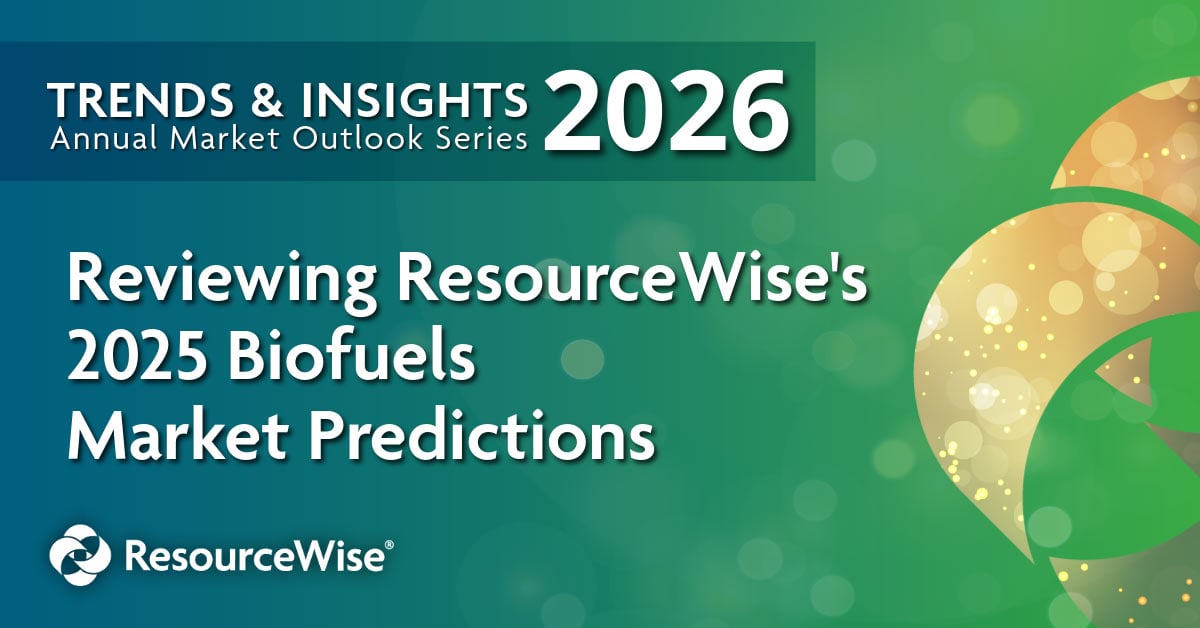3 min read
US EPA Releases RVO Proposals, But Do They Match Pace with the Market?
ResourceWise
:
Jun 17, 2025 10:31:26 AM

Between sharp regulatory moves by the US Environmental Protection Agency (EPA) and renewed Middle East tensions, volatility has surged across global energy markets. The situation became even more energized with the EPA’s release of its updated Renewable Volume Obligations (RVOs) for 2025 and 2026.
Let’s break down what happened, why it matters, and what to watch for next. Also, make sure to register for our on-demand webinar for a comprehensive update on the biofuels market.
EPA’s 2026 Mandate at a Glance
The EPA’s long-awaited RVO release has provided some clarity in an otherwise ambiguous bioenergy climate. And while the numbers imply strong growth, the market’s response has been less-than-enthusastic.
Key RVO Stats:
- Biomass-Based Diesel:
- 2025: 7.12 billion RINs (~4.19B gal renewable diesel equivalent)
- 2026: 7.5 billion RINs (~4.41B gal)
- Advanced Biofuel:
- Added ~600 million RINs, equating to another ~353 million gal of diesel-equivalent demand
- Cellulosic Biofuel:
- Mild increase to 1.3 billion RINs (2026), seen as manageable
A Step Forward, Yet Falling Short of Industry Needs
While the proposal adds over 1 billion gallons year-over-year (YoY), it undershoots the industry’s push for 5.25 billion gallons. This disparity becomes especially evident in light of 169 pending small refinery exemptions (SREs) that could erode real-world compliance targets.
Key Considerations:
- Insufficient Growth Alignment: The proposed volumes, though higher, do not align with the rapid growth and demand in the biofuels sector. The industry has been pushing for more ambitious targets to match the pace of technological advancements and market expansion.
- Pending SREs: The 169 pending SREs pose a significant risk. If granted, these exemptions could undermine the effectiveness of the RVOs by reducing the obligated volumes, thereby impacting the market dynamics and investment incentives in the biofuels industry.
- Market Uncertainty: The lack of clarity and potential for exemptions create an environment of uncertainty. This uncertainty can deter investment and slow down the progress needed to achieve energy independence and environmental goals.
The EPA's proposal certainly shows progress in this market sector. However, it does not fully meet the industry's expectations or the demands of a rapidly evolving energy landscape.
Addressing the pending SREs and setting more ambitious targets are crucial steps toward ensuring the growth and sustainability of the biofuels sector.
Middle East Tensions Amplify Price Volatility
Beyond the EPA’s RVO announcements, markets were already jittery following Israeli strikes on Iran. The result?
- Brent & WTI crude prices surged
- European gasoil markets spiked by $83/t in just two weeks
- Biofuel feedstocks tracked closely behind
Quiet US Feedstock Markets Reflect Policy Caution
With EPA chatter dominating, US grease and tallow markets were unusually quiet. Traders took a wait-and-see approach in light of the uncertainty on how mandates will shake out. Accordingly, we’ll likely see some movement in response to the new RVO insights.
Takeaways: What It All Means
Here’s what to keep an eye on:
1. Policy Uncertainty Lingers
Despite volume increases, EPA’s RVOs have left producers cautious. Watch for updates on SRE allocations and import RIN restrictions.
2. Geopolitical Risks Aren’t Going Away
Oil market shocks ripple instantly through biofuels. Pricing correlations will only strengthen as feedstocks compete with traditional fuels.
3. Feedstock Elasticity Is Critical
With mandates increasing, supply-side constraints — especially in HEFA — may drive the next wave of innovation or disruption.
4. Arbitrage Windows Narrowing
From China to Europe, trading opportunities are tightening. Watch duties, freight, and market sentiment closely.
REGISTER NOW: On-Demand Webinar Covering the Biofuels Landscape
As the EPA’s abrupt news on RVOs shows, the biofuels and feedstocks market can shift at a moment’s notice. That’s why it is so critical to stay informed on what’s happening in this rapidly shifting industry.
To help keep you updated on what’s happening and what’s to come, join us for an on-demand webinar:
Biofuels Market Outlook: Strategic Insights Across Policy, Trade, and Technology from 2025 to 2030
In this session, we unpack the shifting factors shaping the renewable fuels sector, including short-term price swings, medium-term regulatory pivots, and long-term trends pointing toward major transformation.
Whether you're navigating daily volatility or planning strategic investments, this session will help you stay grounded in a fast-paced market environment.
What You’ll Learn:
- The repercussions of recent events like the EPA RVOs and what it will mean for renewable fuels
- How new policies like 45Z tax credits could reshape incentives across the biofuels value chain
- The role of tariffs and trade shifts in feedstock availability and global fuel distribution
- Ongoing efforts to tackle fraud and credibility risks in renewable fuel certification
- Cutting-edge developments in carbon capture at pulp mills and biogenic CO₂ reuse
- Market momentum for sustainable aviation fuel (SAF), marine biofuels, and the next wave of feedstocks






